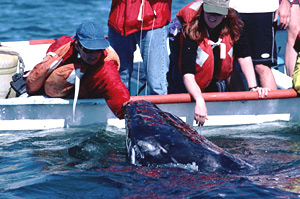 |
 |
 |
 Editorials | Environmental | June 2006 Editorials | Environmental | June 2006  
Number of Gray Whales Increases Along Calif. Coast
 Sadia Latifi - Knight Ridder Sadia Latifi - Knight Ridder


| Gray whales participate in the longest migration of any animal. A year for the gray whale begins in late December when hundreds of pregnant females, along with the rest of the herd, arrive in the warm calving lagoons of Baja, Mexico, after completing an arduous 8,000 kilometre swim, non-stop from the Arctic. Within days of arriving, each cow gives birth to a single calf.  Click HERE for whale-watching info around Banderas Bay. Click HERE for whale-watching info around Banderas Bay. |
For gray whales, reduced ice provides greater access to prey, just the opposite of what we see with polar bears, where reduced ice means reduced access to prey.

WASHINGTON - While many whale species remain endangered, the gray whale calf count along the California coast rose sharply this spring, marine scientists reported Monday.

According to the National Oceanic and Atmospheric Administration, the increase probably reflects the whales' greater access to their Arctic Ocean feeding grounds. That's likely due to warmer temperatures that have reduced sea ice.

'For gray whales, reduced ice provides greater access to prey, just the opposite of what we see with polar bears, where reduced ice means reduced access to prey,' said Wayne Perryman, a biologist at NOAA's Southwest Fisheries Science Center in La Jolla, Calif.

The center has been counting gray whale calves since 1991 from a point of land that pokes out into the Pacific at Piedras Blancas Light Station, midway between Los Angeles and San Francisco. Gray whales swim close to the shore there when migrating between Baja California and the Bering Sea.

The count reached an estimated 1,018 gray whale calves this year. That's up from 945 last year and 300 to 500 in the 1999-2001 migrations.

Perryman attributed the low numbers in that period to unusually cold winters in the Bering Sea.

'Feeding grounds are covered in ice six months out of the year,' Perryman said. 'If a female is pregnant, she's got to put on a lot of fat to get through the next season. And as we saw in those three years when the ice was slow to (melt), if the female can't get to the feeding ground, we've had low calf production.'

Warm-to-cold cycles in Arctic temperatures are 'normal,' Perryman said, and don't necessarily reflect global warming.

Gray whales, which were removed from the endangered species list in 1991, are the only species of whale believed to be at their pre-whaling population size. That's about 19,000 to 23,000 worldwide. Most other whale species remain endangered.

The La Jolla count was only of calves and detected only a fraction of the total migration. A second migration of gray whales moves through the Western Pacific along the Russian and Chinese coasts. | 
 | |
 |



